Hale Library has seen a lot of damage from smoke and water, but even in times of chaos, we continue to capture images of unexpected humor and beauty.



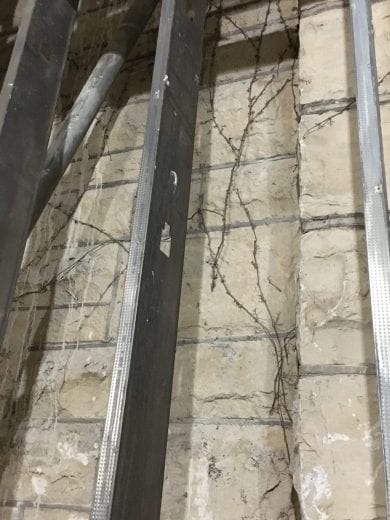






Hale Library has seen a lot of damage from smoke and water, but even in times of chaos, we continue to capture images of unexpected humor and beauty.










The Hale Library fire was unprecedented. Even after the smoke cleared and K-State Libraries’ employees went back to work, it can still be difficult to comprehend the scale of the damage.
“We’ve got 1.2 million volumes that need to be restored and we’ve taken the interior of the library down to the studs,” Lori Goetsch, Dean of K-State Libraries, said. “It’s very significant. That we know of, there is not an academic library in the United States that has experienced devastation at this scale.”
At the July 18 K-State Libraries all-staff meeting in Leadership Studies’ Forum Hall, we turned to Camila Alire, a retired library Dean from Colorado State University (CSU) and the University of New Mexico (UNM), for perspective. Alire is known as “the disaster queen,” having been through not one, but three library crises. She has literally written a book on disaster, “Library Disaster Planning and Recovery Handbook.” In her retirement, she acts as a consultant for libraries who experience similar setbacks.

“Your disaster is extremely hard,” Alire said. “Not only did you have fire, but also you had the water damage. It is going to take you a long time to be back whole again, but I would tell you that this, too, shall pass.”
Goetsch asked Alire to talk to the K-State Libraries’ staff as we consider our future as a library and think about what we can expect during the recovery process. Her hope was that talking about the disasters she has experienced would help give staff members perspective on how to act and react.

“We have all been through a stressful ordeal and there is a lot of uncertainty with that,” Goetsch said. “I invited Camila to our staff meeting to help them understand what we might go through in the next few years.”
On July 28, 1997, just nine days after Alire started her job as Dean of CSU Libraries, Fort Collins experienced major flooding from the Cache La Poudre River. The entire city was affected, but the library was the campus building that was hit the worst.
In only four hours, they received six inches of rain. The water flowed quickly at 5,000 cubic feet per minute and put extreme pressure on the outside library wall. This pressure broke an eight-foot hole in the wall and flooded the entire basement, damaging and submerging over half a million volumes.

While students were locking up the library that night, they went down to the lowest level to check for any remaining patrons, and that was when they heard a crack. They were aware enough to know that the sound was out of place, so they ran back up the stairs. Seconds later thousands of gallons of water poured into the basement, just as they reached the landing. It was the violent flow of the rushing water that did the most damage to the basement. If the water had been stagnant, the flood would not have been as destructive.
“Every bound volume that was down there [was] damaged,” Alire said. “The UFOs (unidentified floating objects) were entirely thrown out.”

A few years later, Alire became Dean of Libraries at UNM. During winter break, on Dec. 24, 2004, a pipe burst in the Science and Engineering Library. There was water damage throughout the entire building and all 300,000 volumes had to be packed out. Luckily, they got to the damage quickly and were up and running a few months later.
“The engineering library was the easiest,” Alire said. “Everything went smoothly, the consultant that they hired to come in was easy to work with, everyone got along, and it was excellent.”
She also commented that it was fortuitous that the flooding happened during a semester break: “Luckily for us—and I think this is probably an advantage when it happened [at Hale]—is you don’t have … a majority of the students and faculty here on campus in the summer,” Alire said.
Finally, on April 30, 2006, Alire faced her last crisis: A major fire in UNM’s Zimmerman Library. This was an entirely different disaster for her to deal with and most similar to what Hale Library experienced. In this case, arson destroyed 28,000 volumes and 60,000 square feet of the building. In total, soot and smoke damage covered 242,752 square feet. The heat was so intense that it melted metal on the bookshelves, but fortunately, a lot of books were salvaged.
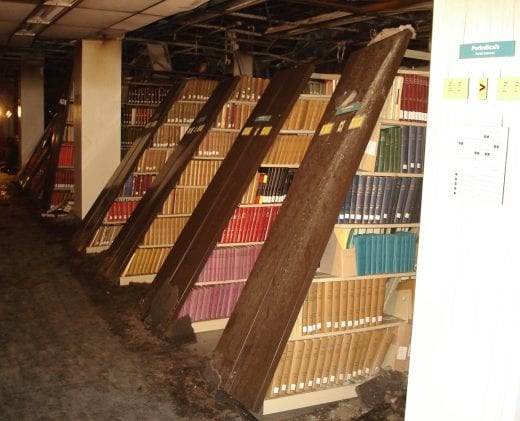
The difference between her three disasters and the fire at Hale was the magnitude. In every event Alire experienced, the libraries were open to the public within a matter of months. Hale Library’s recovery and renovation process might take up to two years to be completely functioning.
“Dean Alire really gave some sage advice on how to get through a major crisis,” Laurel Littrell, planning and assessment librarian, said. “At the same time, it also put our situation in perspective. Even though she’s the country’s foremost expert on library disasters, none of her institutions’ experiences compare to the scope of what happened in Hale Library, especially in terms of how long the building will be closed.”
Alire preached the message that, although this disaster is difficult now, there are silver linings. In our case, Hale was going to be under renovation for the first floor, but now we have the opportunity to renovate all four floors, making the entire building better for students, staff, and faculty
Hale Library is in recovery, but we would not be as far as we are now without Belfor Property Restoration. Their crews have been working very hard for up to twelve hours a day, six days a week in challenging conditions.




Every inch of the library must be cleaned, including the spaces above the drop ceiling grid and the duct work. A Belfor worker stands on a ladder cleaning with a chemical sponge in order to remove the soot. June 28, 2018.





Kathryn Talbot, K-State Libraries’ preservation coordinator, was at home when she received the call about the Hale Library fire on May 22.
“This person kept saying, ‘There was a fire, blah, blah,’” Talbot said. “I literally almost went, ‘I think you have the wrong number,’ before it dawned on me: This is Michelle from work.”
After that call from Michelle Turvey-Welch, the Libraries’ head of metadata and preservation, Talbot came back to campus feeling relatively calm.
“Driving up you didn’t see smoke, so I thought, ‘It can’t be that bad.’”
But when the firefighters were still working four hours later, Talbot knew that she needed to ask Turvey-Welch for permission to call companies that manage large-scale emergency recovery and restoration.

“We were preregistered with two companies that specialize in cleaning up after emergencies like hurricanes and tornadoes,” Talbot said. “So I called to say, ‘I think we might need your assistance.’ After four hours I knew it really was that bad.”
As K-State Libraries’ disaster team lead, it’s Talbot’s job to prepare the organization’s employees for the unexpected and to know whom to call in an emergency. By preregistering with disaster recovery companies, Talbot insured that K-State Libraries would be a priority client in case of a large-scale crisis. For example, in the instance of a tornado that affects multiple organizations, the disaster recovery company helps preregistered clients first.
That was only one element of the team’s preparation, though. Every office was supplied with one of the team’s red “disaster plan” binders, and they stocked strategic points throughout the building with emergency bins and supplies.

“The disaster plan is any library’s bible for how to care for the collection during a time of crisis,” Lori Goetsch, Dean of Libraries, said. “I’m confident that the damage in Hale Library would have been so much more extreme if it weren’t for Kathryn, Michelle, and a really excellent disaster plan.”
Once Talbot had made contact with BELFOR Property Restoration, she also called the American Institute for Conservation (AIC), which has a round-the-clock response line.
“I wanted their help in thinking through the situation and knowing which questions to ask the next day,” Talbot said.
Seeing the aftermath
In the following hours, as the extent of the damage became apparent, Talbot had plenty of questions, but answers were in short supply. She described her experience as she walked into Hale Library for the first time post-fire on Friday, May 25.

“It was really super dark, and I couldn’t believe at the time they had you put on boots,” she said. “I was like, ‘Why am I putting on galoshes?’ Then, as you walked in the back door, you instantly step into water. It’s like, ‘Why is there water in the mail room? That’s kind of weird.’ … And it was dark and intensely smoky. I figured [water and smoke would be] in the Great Room, but not everywhere.”
“We went up all five floors and four of them had water. I knew most of the collection would have to be moved. There was no way that our staff could do that on our own. There was no electricity and … we had tiny LED lights. It was way creepy.”
Talbot went through the building with Belfor staff members who specialize in handling collections and documents after an emergency. They helped prioritize which areas of Hale Library would be addressed first: Room 117 on Hale Library’s first floor suffered the most water damage and the books had to be packed out right away.
By this point, it was Memorial Day weekend, and it became increasingly difficult to contact vendors and arrange supplies. In order to have enough boxes on hand, Belfor’s team bought all of the boxes in stock at Home Depot, Menards, U-Haul and Lowe’s in Manhattan, Topeka and Salina. [Read more about how they recovered wet books.]

Today, a little more than eight weeks post-fire, Talbot cites Turvey-Welch’s constant support and non-stop work ethic for helping her get past each new unexpected challenge. She also praises the Belfor crew for helping her wrap her head around the massive scale of the project
“They’ve been through this before,” she said. “I’m like, ‘What am I not thinking of? … What do you need in order to do what you need to do?’ My dealings with their team have been highly collaborative.”
Past experience
When the Libraries aren’t in crisis, Talbot’s job looks much different. Typically, her main job duties include managing digital preservation and supervising all staff that handle aspects of physically moving books: shifting the collections from one part of the library to another, reshelving books returned by patrons, and storing and circulating books that are located offsite at the Library Annex. She also supervises the care of general circulating collections, including binding and preservation lab activities.
These days, Talbot has a desk in Unger Tower, but she doesn’t spend much time there.
“Every morning I visit Hale at about 7:40 and I do my rounds with my environmental control, I take pictures or I go, ‘Huh. I wonder why that’s like that,’” Talbot said. “I come out, upload the environmental data and send that on, maybe do some troubleshooting. It just depends on the day. It’s not like the early panicky weeks where you’ve got to react right away with some decision. It’s more like, ‘Okay, let’s think this through, because we’ve got 24 minutes to live in the situation.’”

“I would say about a couple weeks ago I stopped waking up in the middle of the night, so I’m either letting it go or I’m just dealing with it better. I think we’re in a better place. It sounds like by the end of August we’ll have everything out of the building. Even if it’s not cleaned, it will be in a better environment than what it is now.”
“I think another anxiety will be when we’re ready to go back,” Talbot said. “The integration … really, I haven’t mentally wrapped my brain around that. There will be a lot of collection decisions that need to be made.”
And is she considering a career change after everything she’s been through in the last two months and the many challenges ahead for renovating Hale Library?
“No,” she said, laughing. “I’m not.”
A few weeks ago we talked about what happened to the wet library books after the fire in Hale Library, but there were also over a million books in the library that suffered smoke damage and require treatment.
The soot from the smoke damaged every inch of the library, and it has proven very difficult to remove from surfaces. A combination of the smoke, water, heat, and non-climate controlled building left most surfaces stained. Typically soot can be wiped away, but in this case, it is almost baked on.
This resistant soot is an anomaly that Belfor, an international disaster relief organization, has not experienced before. Because this is such a strange occurrence, we sent a few books from different parts of the library to the preservationists at the Library of Congress where they will be tested and researched.

“This soot was different from what I typically dealt with in the past because [it] causes a stain,” Kirk Lively, director of technical services at Belfor, said. “It’s not something that you wipe your finger through and you come up with a black smudge on your finger. It’s actually stained onto the surfaces.”
While we wait to hear from the Library of Congress, we continue to move books out of Hale Library over to Executive Court, a process Belfor has been working on since May 25.
K-State leased Executive Court, an office space near the airport that was most recently occupied by the College of Architecture, Planning and Design during the renovation of their Seaton Hall Complex. As of now, books from rooms 117 and 222 have been moved to Executive Court as well as most of 3rd and 4th floors. We estimate 500,000 books are currently at Executive Court waiting to be cleaned.
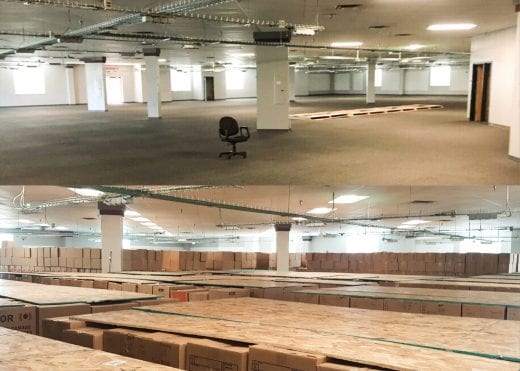
To clean a soot-covered book, a HEPA vacuum is used on the book’s exterior to remove most of the dirt and soot. Next, the cover, the back, and the spine of the book are wiped down with a dry chemical sponge. After the outside is clean, the book is opened and the fore edge of the pages is fanned in both directions and wiped down. It takes about 20 minutes to complete this process on a box that holds 12 to 15 books.
Kay Rieder, Belfor project manager, demonstrates how smoke damaged books are cleaned.
After they go through this manual cleaning process, all of the books will go into an ozone chamber in order to neutralize the smell and draw out the carbon. Belfor has built two ozone containment centers in Executive Court.
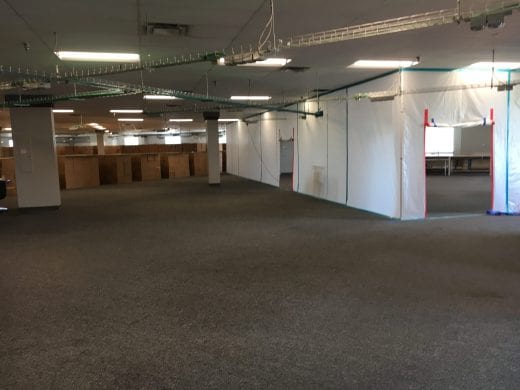
After the books are out of the ozone chamber, they go through a “white glove” quality control check. If any soot comes off the book or a smell still lingers from the fire, that book goes through the cleaning process again. Ozoning books can accelerate deterioration of items, so they will not ozone a book more than needed.

The cleaning process of some of the books has begun, but the crew cannot begin cleaning them in earnest until more warehouse space is acquired to store the clean materials. It is important not to put clean books near the carbon-covered books because the clean books would absorb those chemicals again.

One of the challenges with Executive Court is the inability to move books on pallets, because they don’t fit through the doorways, which slows down the cleaning process considerably. Pallets allow dozens of books to be moved at the same time but instead the boxes are managed by hand and small carts.
Currently, the few hundred boxes that have been cleaned were moved to the Library Annex. The annex is an offsite location near Executive Court that holds part of the Libraries’ collection. Patrons are able to request books from the annex, and then they are delivered to an on-campus library help desk.
After the books are cleaned, some of the books will be ingested into the annex and will be available for check out upon request. The annex is unable to hold the entire library collection, so hundreds of thousands of additional books will be sent to additional warehouse space, once it is acquired.
At Executive Court, boxes are stacked seven boxes high and fill the entire building.
The Libraries have received many questions as to why we don’t claim the books as a loss to insurance. For us, its not just about how much it would cost to replace them.
“Many of our books and other materials are out of print,” Roberta Johnson, director of administrative and IT services, said. “K-State’s resources are the result of years of collecting and carefully managing materials that provide the most relevant information to the faculty, staff and students.”
Not only are some of the books out of print, but it would take an exorbitant amount of time for the acquisitions and collection development department to search for and purchase the material. It would be a major undertaking to replace approximately 1.2 million volumes.
There is no set time frame for the books to be cleaned. As of right now, Belfor estimates it could take between six to twelve months.
Welcome to our week seven Hale Library update!
Now that most floors of the building are emptied and we’re starting to work with a blank slate, truly dramatic changes are less visible. Nonetheless, surprises crop up on a regular basis—some less welcome than others.

Special Collections
The vast majority of the materials from the Richard L. D. and Marjorie J. Morse Department of Special Collections are located on Stack G and Stack H. For weeks, our plan was to clean those materials on the premises.
“We really hoped we could set up cleaning stations in the building and go through the process of vacuuming them and wiping them down to remove soot right here on site,” Roberta Johnson, director of administrative and IT services, said.
Unfortunately, Stack G is getting hotter: A water line that provides cool water to the chilling system was damaged in the fire. It needs to be fixed, but that water line is an area of the Great Room that is currently inaccessible.
This week, we received the news that temperatures in Stack H are rising, too.

“All of the building except the data center in the basement and a few elevators are still powered by generators,” she added. “The cooling system for Stack H isn’t getting reliable power, and until good commercial power is available, and the unit’s electrical issues are resolved, these problems will continue.”
So the materials in both Stack H and Stack G will be packed out soon and transferred to Executive Court, the storage and cleaning facility near the airport.
“In some places, the building conditions are getting worse instead of better,” Johnson said. “We just can’t risk leaving valuable materials in non-climate controlled space.”
The Great Room

Additional scaffolding has been constructed in the Great Room. Once complete, crews will build a floor across the top; from that floor they will be able to reach the ceiling and start the restoration process.
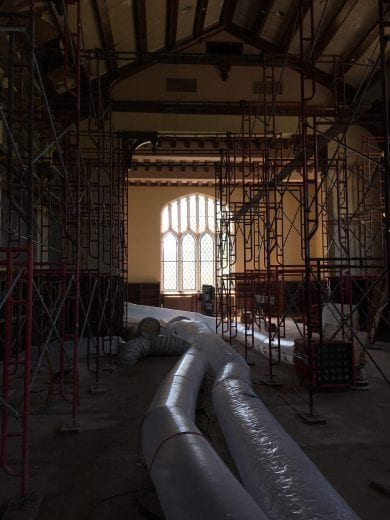
Julia Manglitz, a professional art restorer, is on-site to oversee efforts to preserve the Great Room murals, which were painted by David Hicks Overmyer in 1934.
“Her goal is to dry the plaster out very slowly in order to cause the least possible damage to the murals,” Haddock said.

He also explained that she is using a large black light to examine and photograph the murals because the UV light can make damage on the painting’s surface readily visible.
The “We are the Dream” mural is in the Academic Learning Center, which is on the opposite side of the wall from the Great Room Mural. Manglitz hopes to remove the “We are the Dream” canvas from the wall as the plaster dries, but that painting is in less-than-ideal condition and the outcome is uncertain.
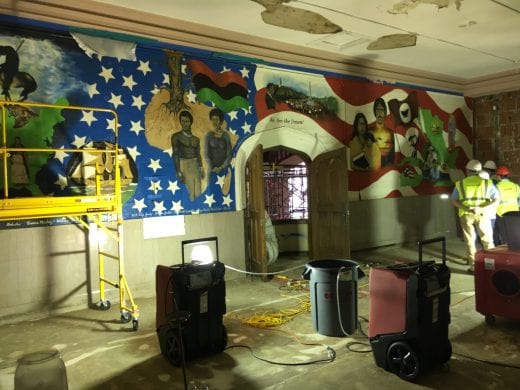
In a related effort, there is a full painting crew in the Academic Learning Center, but they are actually “unpainting,” or removing the paint from the walls, thereby erasing a barrier that is preventing the plaster from drying out.
The next step will be to remove the ceiling in the Academic Learning Center, another part of the effort to eliminate moisture from the environment.
One building challenge and one bit of trivia
Meanwhile, up on the roof, there are three very large, non-functioning air conditioning units that will have to come off. (Well, two very large ones, and one very, very large one.)

“It’s a challenge we haven’t quite managed to come up with a workable solution for yet,” Mike Haddock, associate dean, said. “There’s been talk of everything from dismantling them and bringing them down in pieces to airlifting them off with a helicopter.”
Stay tuned for those photos, right?
About a month ago, we shared photos of the dehumidification tubes that prompted references to science fiction pop culture.
Well, sci fi fans, meet the hydroxyl generator.

There are multiple boxes emitting an eerie blue glow across fifth floor. These hydroxyl generators use a phenomenon that occurs in nature to neutralize odor left by the fire.
Hydroxyls are molecules that are created when sun’s ultraviolet rays react with water vapor in the air; however, they don’t occur indoors. The generator creates atmospheric hydroxyls that neutralize smells by breaking down the chemical bonds in the odor-causing bacteria molecules. Hydroxyls also neutralize some molecules in mildew and in mold spores. The machines are safe for use in occupied areas.
If you were told to inventory the contents of your house, apartment, office or dorm room, where would you start? How many total items would be on your list?
In order to file an insurance claim after the May 22 fire, the K-State Libraries administration has been managing that overwhelming task. Roberta Johnson, director of administrative and IT services, walked us through the process of inventorying a building that’s bigger than nine football fields.

Johnson explained a series of steps have to be completed before the insurance company will provide financial compensation. Several tasks have been finalized.
First, K-State’s insurance company subcontracted with an insurance adjuster (in this case, Crawford & Company). Crawford & Company will work closely with Belfor, the recovery and restoration company, in determining the extent of the damage that was a result of the fire and the subsequent water exposure.
Before that happens, though, the entire contents of the building had to be inventoried and a determination made as to what was or was not salvageable, so Crawford & Company subcontracted with two more organizations. RCF Salvage inventoried all fixtures, furniture, and equipment (FFE) in the building, and Envista Forensics inventoried technology, which included everything from computers to the digital displays and checkout machines.

“I feel like I have nine million people to deal with,” she joked. “At one point there were 15 different agencies in the building, companies that have come from all over the country, Georgia, Indiana, Texas … to work on this project.”
The whole inventory process started on May 28, just six days after the fire. The bulk of the work was completed in about three weeks.
Either Johnson or K-State Libraries’ building manager, Robin Brown, walked through Hale Library with RCF Salvage’s staff to verify every single item that was inventoried. They signed what Johnson said felt like reams of carbon paper in the process, and the resulting 367 page FFE inventory included 7,749 line items. In many cases, just one of those lines represented more than one thing; for example, one entry might be a record of 35 wooden chairs.

Envista Forensics produced a second inventory report that included approximately 1,970 pieces of technology.
“Keep in mind that almost all of this was done by flashlight because there was no power in the building,” Johnson said. “We did have temporary lighting toward the end, but I just thought these were the world’s worst conditions for the work. They sifted through the contents of every office, cubicle and storage space. And yet they were still so professional. I’ve been amazed.”

So what happens next?
“This is a 550,000-square-foot building; there are a lot of nooks and crannies,” Johnson said. “We’re still coming across items, and occasionally we have to go back to the inventory to make sure they’ve been accounted for. It will take time to clear up any discrepancies.”
Only once the loose ends are tied up can the adjuster valuate the inventory and provide a dollar amount to the insurance company.
“Even once the inventory process is finalized, we still don’t have estimates about the structural damage itself,” Johnson said. “That’s an entirely separate process. And until we have that piece in addition to the inventory of the building’s contents, there won’t be a total damage estimate.”
In the meantime, Johnson says she does have some idea of what the largest losses will be in terms of expense.
“The servers in the basement are among the most expensive single items,” Johnson said.
Other big ticket items include the fixtures: cubicle walls, desks and workstations.
 During the inventorying process, first floor was used as a holding area for furniture and boxes of books. June 11, 2018.
During the inventorying process, first floor was used as a holding area for furniture and boxes of books. June 11, 2018.
“Right now they’ve carted out more than 100 industrial-sized dumpsters full of fixtures and furniture, and they’re not done yet,” Johnson said. “The loss is massive.”
Johnson is highly pragmatic about the whole process, though.
“We had no injuries,” she said. “When you think about the extent of what happened, that’s the most important thing. No injuries. I’m so grateful for that.”
Employee Possessions
Of course, there are more than 100 K-State Libraries and IT Services employees who had offices and workstations in Hale Library, and most had personal items at their desks – everything from art to clothes to their own technology. An inventory of those items was compiled separately, and employees will make claims to the insurance agency at a later date.
Among some staff members, there’s a running bet as to whose office held the most personal items. Two of the academic services librarians, Melia Fritch and Cindy Logan, are the odds-on-favorites, so we asked them about their experience.
“There was such a sense of disbelief when we learned our office was a loss,” Logan said. “We have had so many fire alarm situations where nothing was damaged, I just thought they had to be wrong … there was no way there was that much damage. It took probably a week before the news really set in.”

On May 30, Fritch, Logan and their Hale Library co-workers were allowed in the building for the first time to retrieve any personal belongings that were salvageable.
“It was pretty surreal visiting the office for the first time after the fire,” Fritch said. “We walked through with all the safety gear on and carrying flashlights, and it was so hot. The most disturbing thing was going into to our office and feeling like FEMA had been through since there were these orange spray-painted words like “demo” all over the walls. That was weird.”

Fritch and Logan’s second floor office was packed with art, books, photos and objects. They both say they surround themselves with things that remind them of people they love, books about subjects they’re passionate about or quotes that express core beliefs.
“What I really miss is the artwork that my son had done throughout the years that I had hanging up,” Fritch said. “I was super happy that some of Tyler’s artwork was safe and I could take it, along with some photos I really wanted. Of course, I miss the Keurig, too—ha!—but the material objects, the decorations, the computer, the chair, books … those can be replaced.”
A video of Melia Fritch and Cindy Logan’s office taken shortly before the fire.

Logan, who laughingly admits to something of an office supply addiction, agreed, and added that she looks forward to the day when they get to move into a new space.
“For now, I miss having my 20 million different markers, highlighters, pens, notebooks and types of Post-it notes,” she said. “But I look forward to our new bright and shiny offices and making them feel like home once the building has been renovated. My office reflects me, and I will continue to fill it with things I love and from the people who love me.”
Today marks six weeks since the fire at Hale Library. Since last week, carpet has been completely removed from several floors, more of the drop ceiling system has been taken out, scaffolding has started going up in the Great Room and crews have begun the labor-intensive process of wiping soot from every surface in every room.
As you’ll see here, the some of the changes are quite obvious!
The Great Room
The Great Room was the area that received the most damage from the fire, and it will take the longest to restore. In perhaps the most visually dramatic change, scaffolding is being constructed throughout so that crews can access the walls and ceiling and start the cleaning and restoration process.

The murals are on plaster walls that are still drying out, and we are working with preservationists in order to save them.


The First and Second Floors
If you read our five-week update, you know that most of floors have been cleared of furniture, carpet and drop ceilings.
As of this week, the first and second floors are completely empty. It’s exciting to see a blank canvas emerging. Now the area can be cleaned, and we can start thinking about its future.





Isolated Mold Outbreak in the Stacks
The library is a 550,000-square-foot building, and most of it is still without commercial power, which means that many of our inspections have been conducted with flashlights.
Of course, we are always looking for emerging problems throughout the building, even in places where we initially thought the damage was minimal. However, we now know that lack of light prevented us from identifying one area of concern.
In the last week, we found mold in a small, isolated section of the stacks.


So what happened? As the hundreds of thousands of gallons of water that permeated the building during the fire drained from the top floors to the bottom, it flowed along any unrestricted path available. Initially, the stacks were dry, but some of that water drained down the edges of a pipe. Since there is a gap around the pipe where it passed through each floor, water seeped through to the levels below. As the water progressed down the exterior surface of the pipe, books in the immediate vicinity got wet.
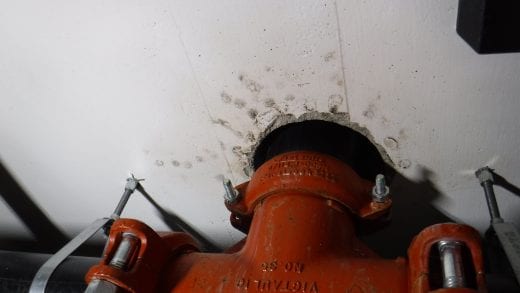
Since this discovery, we have removed the affected books. We remain vigilant for similar leaks and pockets of moisture throughout the stacks.
Packing and Removing Books
Since the last update, we continue to remove books from the library for cleaning at an offsite location. Currently, crews are boxing and moving books on the third and fourth floors.
As of July 2, crews have packed more than 38,000 boxes of books and library materials.
Until June 28, the elevators were operating thanks to power from generators, but the elevators still didn’t have lights, so crews were moving books from the upper floors to the ground floor in the dark.


Cleaning Fifth Floor
The fifth floor was relatively unscathed, but it still needs to be professionally cleaned to remediate soot and smoke damage. Even ductwork will be cleaned throughout the entire building.
On fifth, crews are cleaning every accessible surface that was exposed to soot and smoke. It’s a very labor-intensive process. First they vacuum all surfaces—walls, windows, doors, everything—with a HEPA vacuum, which is a vacuum affixed with a filter that can capture particles of 0.3 microns with 99.97% efficiency. Next, the crew goes over everything again with dry chemical sponges. And finally, they wipe the surfaces down with clean washrags.
This process will be repeated on every surface throughout the entire building.

In the fifth floor, ceiling tiles have been removed, which makes the ductwork accessible for the cleaning crew.

All surfaces are cleaned with HEPA vacuums before they are wiped down with chemical sponges.

In order to reach every inch of the soot with a chemical sponge, the crews put them on long poles.

Emptying damaged furniture, construction materials and books from the library is part of the process of creating a clean slate. Day-to-day, sometimes it feels like a slow process that requires an overwhelming amount of labor. When we think about the big picture, though, it’s an exciting first step toward renovating Hale Library and creating a new, vibrant research environment that will serve the entire K-State community.
We’re taking a break for the rest of the week, but check back early next week for the latest Hale Library news! Have a fantastic Independence Day, all!